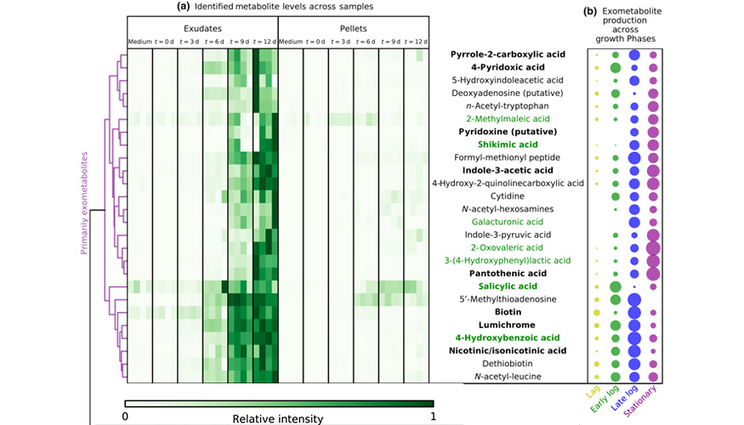Algal activities shape surrounding bacterial communities
 (Download Image)
(Download Image)
Phaeodactylum tricornutum metabolite production across growth phases. (a) Heatmap showing half of the 50 identified metabolites’ relative intensities across samples. b) Exometabolite accumulation during each of the four growth phases. Circle size represents the production (relative intensity increase).
Microalgae play important roles in global carbon cycling and industrial applications for bioproduct and biofuel production. As with land plants and other host–microbial systems, microalgal activity, productivity, and stability are closely tied to surrounding microbial communities. However, a predictive understanding of microbial community interactions with algae is still limited.
Algal exometabolites, for example, are hypothesized to be a primary way by which host organisms influence microbiome composition. Exometabolite release would take place when an algal cell breaks down (or metabolizes), releasing by-products into the surrounding microbial community. In a study published in New Phytologist, researchers from Lawrence Livermore and Lawrence Berkeley set out to test the hypothesis that algal exudates drive microbial community composition and to identify specific algal exometabolites that can be linked to specific changes in algal-associated microbial communities.
For their experiments, the team studied exometabolite release from an alga known as Phaeodactylum tricornutum and identified 50 metabolites. Exometabolite production was found to be dynamic, with different exometabolites accumulating in the tested cell culture media during each of the four algal growth phases. For example, some exometabolites only accumulated in the early growth phases and were not detected in the later phases, while others only accumulated in the later phases and not in the early ones.
Additionally, one metabolite, 4-hydroxybenzoic acid, was characterized in more detail. In these experiments, 12 bacterial strains were isolated with 4-hydroxybenzoic. It was found that only some of these bacterial isolates could use 4-hydroxybenzoic acid as a carbon source. Overall, the team’s results demonstrate the multifaceted role of algal extracellular metabolites in shaping algal-associated bacterial communities. Furthermore, this research suggests that other exometabolites, yet to be characterized, could positively or negatively influence specific bacterial groups.
[V. Brisson, C. Swink, J. Kimbrel, X. Mayali, T. Samo, S.M. Kosina, M. Thelen, T.R. Northen, R.K. Stuart, Dynamic Phaeodactylum tricornutum exometabolites shape surrounding bacterial communities New Phytologist (2023), DOI: 10.1111/nph.19051.]
–Physical and Life Sciences Communications Team







